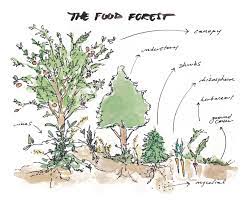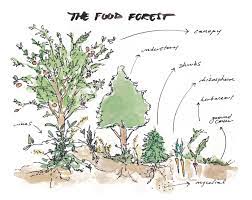Food forest
Courtesy : www. tenth acre farm.com
A food forest mimics a forest edge that is planted with edible plants.
Picture all of the vertical layers of a forest growing together: Tall trees, small trees, shrubs, herbs, and ground covers. Tall, canopy trees grow inward from the edge. Correspondingly, smaller trees peek out from underneath the tall trees to catch the sun’s rays.
Shrubs step farther out into the sunshine, along with herbs, flowers, and ground covers blanketing the sunniest edge.
A typical forest edge can look a little busy. Sometimes vines grow up the trees and mushrooms grow under the tallest trees in the shade.
All of these layers of the forest stack together, each situated for sufficient sun exposure. Intertwined, they produce a vibrant, productive, low-maintenance, and relatively self-maintaining ecosystem.
A healthy forest doesn’t need humans to weed or fertilize.
An example food forest might include chestnut trees as a tall canopy tree layer. Apple trees grow below the chestnut trees. Meanwhile, currant bushes grow as an understory layer beneath the apple trees. A host of edible herbs and mushrooms grow underneath, and perhaps even grapevines use the apple trees as trellises.
Swap out my selections above for your favorite nut trees, fruit crops, and herbs to make your own system!

Berries growing in a food forest
History of the Food Forest
Managing forests for their edible benefits to humans is an ancient practice. In fact, existing ancient food forests have been found in Africa, Asia, and the Americas.
As the New World was colonized, the colonists and anthropologists didn’t know that they were looking at managed systems. To them, the forests in front of them looked like untouched forest.
What we realize now, of course, is that the early hunter-gatherer societies didn’t wander around aimlessly in search of food.
In fact, they knew which areas produced which desirable foods or medicines, and at which time of year. It informed their movement.
As they moved through forest and prairies areas, they encouraged desirable plant species by cutting back the growth around them. Ultimately, giving them the space to grow abundantly helped them thrive and reproduce.
It was an early form of forest gardening.
They wouldn’t have spent a ton of time tending this space. However, the desired plants would certainly be given an advantage over other plants.
Geoff Lawton found a 2,000 year old food forest in Morrocco. Incredibly, 800 people continue to farm this desert oasis. Among other edible plants, you’ll find date palms, bananas, olives, figs, pomegranate, guava, citrus, and mulberry.
Likewise, he found a 300 year old food forest in Vietnam that has been cultivated by the same family for 28 generations.
With these ancient stories in mind, we can create vibrantly abundant perennial gardens that require less maintenance. Above all, they can be a legacy left for future generations.
This is the inspiration behind the modern food production strategy called a permaculture food forest.
Want to grow fruits, vegetables, and herbs in your front yard landscape without sacrificing curb appeal? Check out my ebook, The Permaculture Inspired Edible Landscape.
The Benefits of an Edible Perennial Forest Garden
Perennial gardens don’t disturb the soil regularly like annual gardens do. Rather, they continually enrich soil with organic matter as leaves fall and plants die back for the winter.
Consequently, the food forest model can help to restore land, biodiversity, and habitat while creating an edible yield.
A forest is one of earth’s most stable ecosystems. In fact, when we mimic it in food production, we get all the ecological benefits of a forest PLUS food!

Apple orchard
Food Forests vs. Orchards
Imagine planting a 0.10-acre site with about 30 apple trees to create a mini orchard. For the home gardener, this would obviously yield a lot of apples!
Still, a single-species orchard can be a tough space to manage. As a monoculture, it may attract pests and diseases that discover the smorgasbord of their favorite food. Consequently, this would require you to spend time and money on pest/disease treatment.
The standard apple orchard arrangement also doesn’t take advantage of the vertical space above and below the trees. There is a single harvest opportunity of apples. Most importantly, if it’s wiped out by a disease or pest, there’s no reward for your efforts.
The single species—all needing the same nutrients in the soil—would, over time, deplete the soil and require imported fertilizer.
How would that work?
Would you like to learn more about using permaculture techniques to improve the biodiversity of your garden, reduce maintenance, and increase yield?
You’ll find loads of information just like this in my award-winning book, The Suburban Micro-Farm.
The Apple Orchard Transformed into a Food Forest
Imagine planting the northern edge (in the northern hemisphere) of the orchard with a row of tall nut trees. Alternatively, stagger rows of apple trees with plum and cherry trees, for example.
Likewise, in a commercial operation, select fruit crops with high economic value that demonstrate ease for commercial harvesting. In the rows with the fruit trees, you could plant some nut- or berry-yielding bushes.
Underneath and between all the trees and shrubs we could seed a variety of herbs and flowers that help to:
- add nutrients to the soil (fertilizer and soil building)
- attract beneficial insects (pest prevention)
- attract pollinators (for better fruit set)
- add potential harvests in the form of cut flowers and culinary/medicinal herbs
Some of my favorite understory herbs are yarrow, calendula, chives, comfrey, and daffodils. I like to seed the whole area with clovers.





